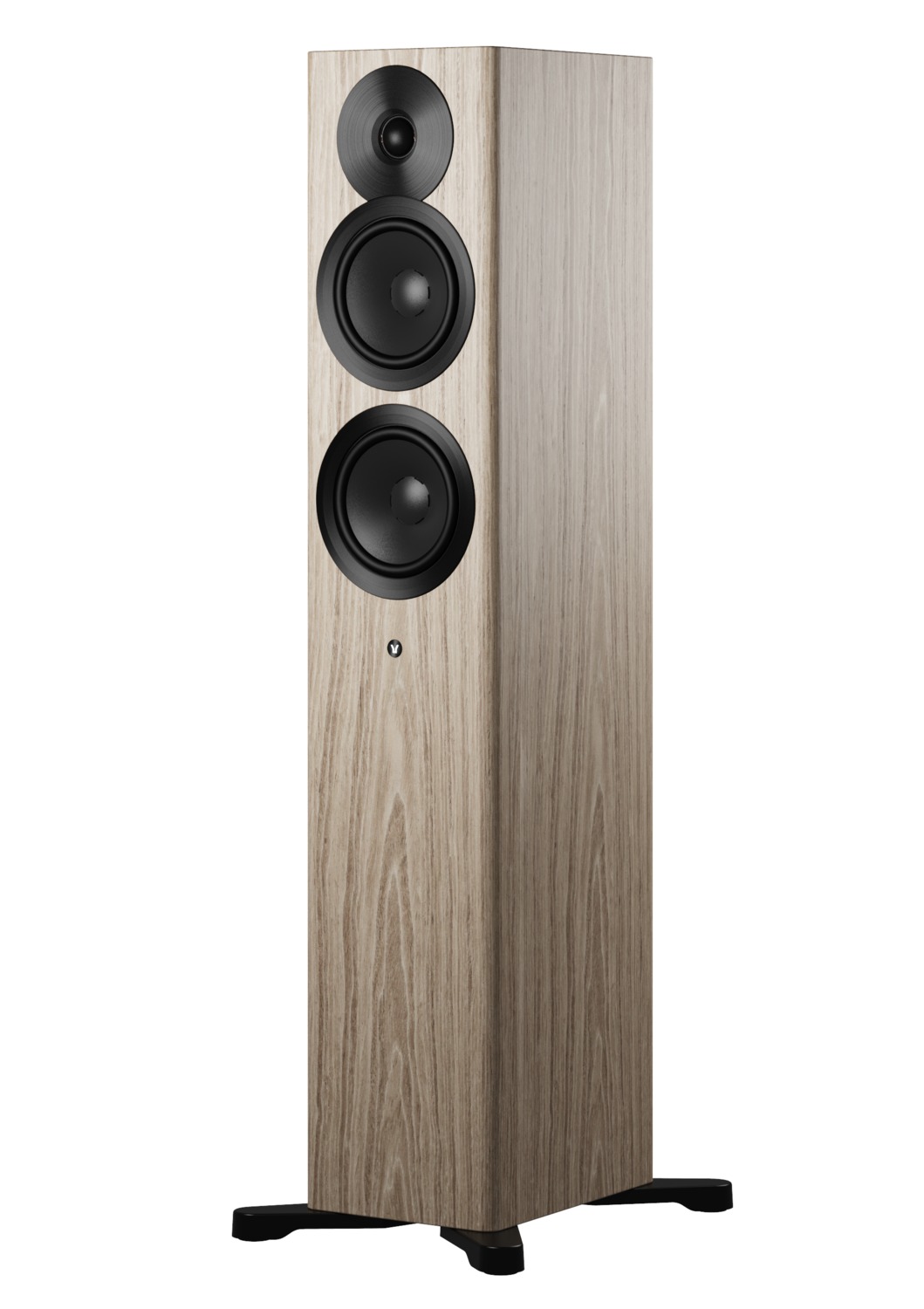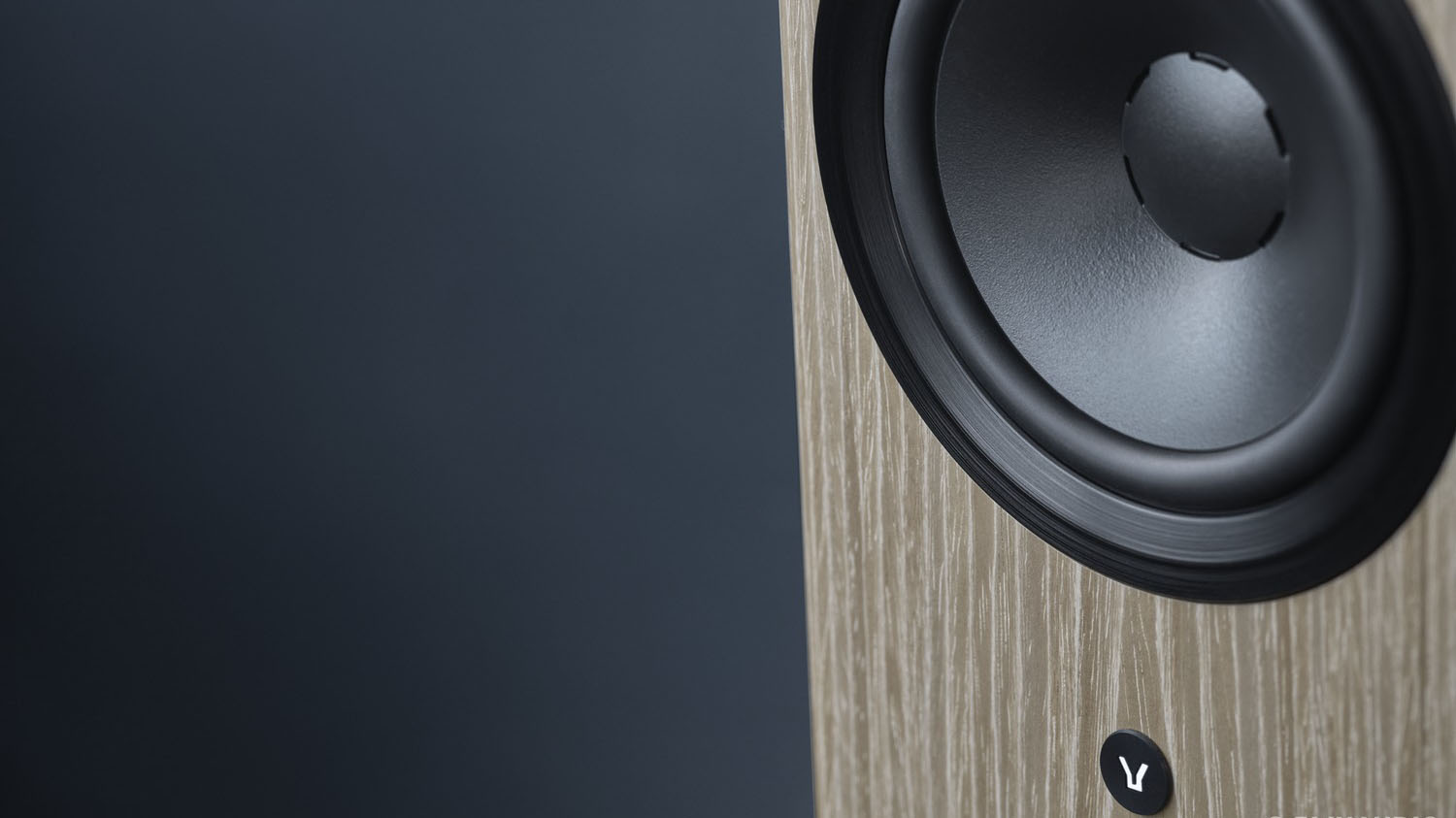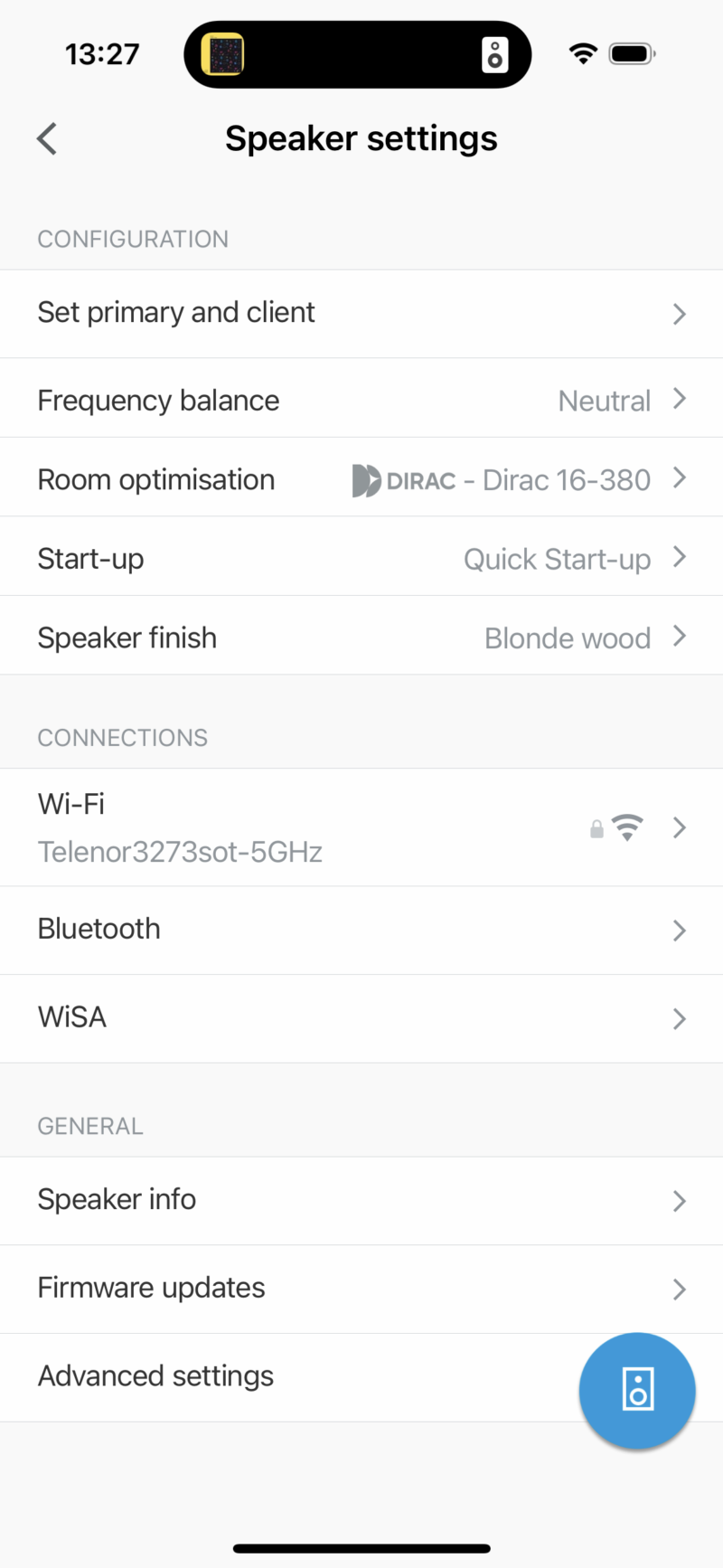It shouldn’t really be possible for something this small to play so loud and clear, and with a bass reproduction that you can feel in your body. You look around to see what beast of an amplifier is driving the modest speakers, and where is the subwoofer?
The new Dynaudio Focus 30 look like most speakers. Barely 90 cm tall and so narrow that it will hardly be difficult to find space for them. Two small drivers (a midwoofer and a dedicated woofer) of 14 cm each take up almost the entire 18 cm wide front. Above those two is a new Dynaudio tweeter, and that’s it. No hidden woofers inside. Not even a bass reflex port.
And yet they play with an authority normally associated with speakers twice their size.
You might ask yourself how that’s possible.
Luck? Hardly. Dynaudio has years of experience with active speakers. We know the Xeo and Focus XD series from previous tests, but many may not know that they also have a professional division that manufactures active studio speakers.
This experience is combined with a newly developed wireless module that makes the new Focus series completely wireless. You need a power cable for each speaker. That’s it, that’s all. No additional devices or wireless receivers.
It’s all built in.
New Focus generation

The Focus 30 floor-standing speaker is the middle model in a series that also includes a larger three-way floor model called the Focus 50 and a compact two-way called the Focus 10. All three are built with exactly the same technology on the inside. The Class D amplifier modules were developed for the Focus series by Pascal in Denmark. The drivers are Dynaudio’s own. The bass and midrange use the MSP diaphragms familiar from other Dynaudio speakers, and the new Cerotar tweeter features Dynaudio’s Hexis diffuser behind the 28mm diaphragm. Which is powered by a 110-watt Class D module, while the other two units each have 280 watts of power.
The speaker is actually constructed as a 2.5-way speaker system, with both woofers playing from 18 Hz (!) up to 220 Hz, one cutting off upwards, while the other continues up to the tweeter at 2400 Hz.
This is possible because the speakers’ digital signal processing controls both the split between the units and the power going to them. If you play low or moderately loud, the speakers are – at least in theory – capable of playing down to 18 Hz. When you turn up the volume, the DSP adjusts the power used for the woofers, attenuating the lowest frequencies to prevent the distortion from becoming audible and the woofers from eventually smoking.
Dynaudio says the speakers roll off in the mid-30s when played very loudly, and this matches up well with our measurements.
Dirac room correction
Because the speakers can be measured. Not in the same way as you measure the setup of a surround receiver and speakers with a small plastic microphone connected to the receiver. But with a measurement microphone connected to a laptop.
With Dirac Live installed on the laptop or an iPad, iPhone or Android device, you can calibrate the sound in the room the speakers are in. This simply means that you can measure the response in the room, either over the entire frequency range or a limited part of it. For example, the bass, if you have problems with the bass response in the room.
You can save up to six profiles based on the measurements and adjust the tonal balance to your liking. If you like a little more weight in the bass, or maybe you want to dampen the treble a bit, you can save a profile in your Dirac account, which you can also find in the Dynaudio app that you use to set up and control your speakers.
No measurement microphone or Dirac license is included. You have to get these yourself, but the idea is that the dealer will come to your home and do the room correction for you if you wish.
Wireless – also with WiSA

While previous Dynaudio speakers didn’t achieve wirelessness without a wireless receiver, everything is built in here. One of the speakers is the primary device for connections, both physical and wireless. You can easily pair the speaker to your phone via Bluetooth for convenience, but you should connect them to your home Wi-Fi network for the best sound.
It’s worth noting that Dynaudio has opted for WiSA instead of HDMI, which is normally used when connecting TV audio to a speaker. WiSA is a wireless standard used by LG, among others, that sends the TV sound wirelessly to the speakers the TV is paired with.
The main speaker has a pair of analog RCA inputs for an analog audio source, a digital optical and a coaxial input, and a subwoofer output (80 Hz high pass). So far without bass control, where you usually set crossover and other parameters on the subwoofer output. But according to Dynaudio, this will come later on the app.
There is also an Ethernet jack on the back for wired network connection, and a digital coaxial output that you use if you want to connect the speakers by cable. This supports 24 bit/192 kHz resolution, while the wireless pairing of the speakers supports 24/96.
Dynaudio app
The speakers support AirPlay 2, Chromecast and DLNA/UPnP connectivity, and they are Roon Ready, so you can control your music with a Roon app.
There is support for Tidal and Spotify playback in the app, but so far Qobuz is not integrated into the app’s music management. Neither is Apple Music.
However, there are a number of radio stations in the app. On the remote control, there are three programmable buttons where you can set your favorite station or preferred streaming service.
If you want to change basic settings or simply adjust the tonal balance to lighter or darker – neutral is the alternative – you’ll find that in the app too. Here, the aforementioned calibration profiles are also stored under Room Optimization.

First impressions
The first time I saw a pair of Focus 30s was at High-End in Munich in 2022. I was struck by how small they were. Especially when standing next to the 110 cm tall Focus 50, which is also much wider and deeper than the Focus 30.
It was natural to think that a pair of Focus 50 would be the closest rivals to the fantastic KEF LS60 Wireless, but the fact is that the Focus 30 is the closest in price to the KEF speakers.
It was therefore with some skepticism that I unpacked the speakers. They weigh only 16 kilos and are easy to handle. So I attached the feet, mounted the spikes, and hooked them up, ready to listen to them for a couple of weeks of reviewing. I barely listened to them at the time, but a few days before Michael Cordt Møller and Sebastian Glansk from Dynaudio were due to come and calibrate the speakers, I sat down for a test listen.
I must admit that any skepticism was quickly put to shame. After setting up and connecting to Wi-Fi – a quick and painless process – I played a selection of music from Tidal through the speakers.
It’s hard to believe it’s true, but the music flowed out of the speakers with an authority and dynamics I hadn’t expected at all. They extended much deeper in the bass than I thought, and they could play more clearly and louder than any other speaker I’ve heard of that size.

Compared to KEF
A comparison with the KEF speakers is inevitable, and there are distinct differences in the way they present the music. The KEF speakers have more weight in the bass – eight versus four woofers – but the Dynaudio speakers’ bass response is tighter and better defined. The stereo perspective is more sharply defined and the soundstage is larger with the LS 60 Wireless, but the soundstage is more open and transparent with the Focus 30.
The design has little to do with the sound, but the futuristic white, black or blue design of KEF speakers isn’t for everyone. Certainly not those who prefer the warm wood veneer of light oak or walnut veneer that the Focus speakers come in. As well as the compulsory black or white cabinets.
Whatever the finish, the speakers come with the Smart Grille front cover, which attaches magnetically. When you turn it on or off, the LEDs on the front of the speaker flash and the DSP compensates for the acoustic changes that occur when you turn the grille on or off.

Airy and transparent – and what dynamics!
I often use the opening track from Keith Jarrett’s Cologne concert when testing, or other piano music, because a piano is so incredibly difficult to reproduce correctly. Many loudspeakers struggle with the lowest octaves of a concert piano, often the crossover frequency of the loudspeakers is in the sensitive area of a piano’s range, and here you immediately feel the effect of a proper crossover.
The recording sounds warm and sonorous with the KEF speakers, and the speakers do an exemplary job of following the transients in the recording. The Dynaudio speakers don’t deliver the same warm sound, but the piano sounds better with the Focus 30. The nuances are more clearly defined and the treble reproduction is airier.
The bass from the bass drum on Rohey’s Tell Me goes basement deep in our test room. When I turn up the volume, there’s no change in control in the bass register. It’s total, the speakers deliver bass with an authority that far exceeds the size of both the speakers and the woofers. I have hardly ever heard anything like it.
Sebastian and Michael set up and calibrated the speakers in the test room and stored several profiles in Dirac Live for me to use in the app. You can also create profiles for those who want to listen in the so-called sweet spot, or for example use the room correction to compensate for and equalize different placements of left and right speakers.
In our test room, Sebastian used a UMIK-1 USB microphone to take five measurements, which I alternated between in the app. It was enlightening, because although some of the corrections tightened up the bass and pulled the soundstage in a very neutral direction, not unlike a studio speaker, I ended up using default most of the time. So no room correction.

I also brought the speakers to my private listening room, which is not as damped as our test room. Here, the speakers could resonate more in the room and the soundstage also grew, compared to our very heavily dampened test room.
That’s when I noticed another thing. When the speakers were placed in another room, they didn’t change in character, but some characteristics came through better. The bass became fuller, it was still tight, and there was more punch on the percussion on the Arild Andersen Group’s ‘Short Story’ from the album Affirmation, and the dynamic contrast improved.
Carl Nielsen’s 2nd Symphony with the Danish Radio Symphony Orchestra came out really well. The unwavering focus of the speakers makes the strings shine, and you can both hear and sense the physical size of the strings. However, it should be noted that I think a dedicated midrange unit would give both strings and woodwinds more depth and body. It doesn’t matter so much on Karpe’s PAF.no, which needs rhythm, timing and dynamics more than anything else. And here again, the Dynaudio speakers show how insanely good control they have and how perfectly balanced they actually are.
Conclusion
Compared to the KEF LS 60 Wireless, the smaller Dynaudio speakers are at least as good at audio reproduction. But they play and sound differently. The English speakers give the music more warmth and fuller sound – especially in the midrange, while the small Danish wood veneer speakers sound more neutral, more open and slightly better focused. Especially in the lower octaves. Choosing between the two will be a matter of taste, both in terms of design and sound quality, but there is no doubt that the Dynaudio Focus 30 is absolutely perfect as a wireless speaker. It doesn’t need Dirac Live room correction, but the option to have it makes them extra interesting for anyone who wants better sound but has a room that can challenge the sound quality of such expensive speakers. With Dirac Live and a pair of Focus speakers, it’s even easier to get optimal sound in your home.

We think
Exceptional openness and focus on timbral nuances. Absolutely perfect as a wireless speaker, with furnishing-friendly size and room correction that optimizes the sound for the room. The room correction costs extra if you have to do it yourself. The status LED on the front does not replace a display.
7500 €
Specifications
- Type: Wireless, Active floorstanding speaker
- Woofer: 14 cm MSP
- Midwoofer: 14 cm MSP
- Tweeter: 25 mm Cerotar with Hexis
- Power: 280 W + 280 W + 110 W
- Sound pressure: Not stated
- Frequency range: 18 Hz – 36 kHz – 6dB
- Crossover frequency: 220, 2,400 Hz
- Wireless: Bluetooth 4.2, Wi-Fi, AirPlay 2, Chromecast, WiSA, UPnP, Roon Ready
- Streaming services: Tidal Connect, Spotify Connect, Qplay
- Connections: Digital Coaxial, Toslink Optical In, Ethernet, USB-A, Analog RCA, Subwoofer, RCA Out
- Dimensions and weight (cm / kg): 90 x 18 x 26 / 16.2
- Colors: Walnut, white, black, light oak
- Web: dynaudio.com






